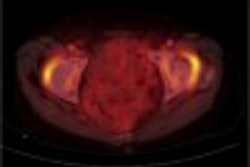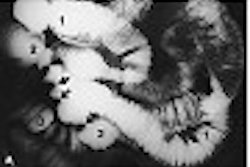CHICAGO - Virtual colonoscopy had a high predictive value for the presence of colorectal masses after failed colonoscopy, according to researchers from the Beth Israel Medical Center in Boston. There were too many false-positive findings among the larger polyps, but VC still succeeded in detecting the most important lesions.
“Failure to reach the cecum in a well-prepared colon occurs in 3-10% of patients undergoing (conventional) colonoscopy,” said Dr. Laurien Copel at the gastrointestinal sessions of the 2003 RSNA meeting. "High-quality double-contrast barium enema may be untenable post-colonoscopy, as over 50% of polyps 10 mm and larger may be missed,” he added.
That leaves the virtual exam as the brightest hope for finding significant colorectal abnormalities in patients who must bow out of conventional colonoscopy for reasons ranging from excessive discomfort to redundant or tortuous bowel loops, or obstructive lesions that prevent the colonoscope from advancing to the cecum. Failed colonoscopy is one of the few areas where reimbursement for diagnostic colonography can be expected routinely.
Over five years, Copel and colleagues performed virtual colonoscopy on 625 patients (ages 39-88, mean age 63) following failed colonoscopy, representing 7.4% of all conventional exams. Endoluminal findings 6 mm or larger were seen in 99 patients (13.4%).
Of these, the researchers found 13 masses larger than 20 mm in 13 patients, 12 positive and one 1 negative at follow-up colonoscopy. True-positive findings included 7 adenocarcinomas, 3 ileocecal lipomas, 1 case of ischemic colitis, and 1 case of wall thickening due to adhesions. In addition there were 22 large polyps (10-19 mm) in 18 patients, and 61 medium-sized polyps (6-9 mm) in 69 patients.
Follow-up colonoscopy showed VC’s sensitivity to be 100% for masses larger than 20 mm, and 94% for polyps 10-19 mm. Six patients with polyps 10-19 mm turned out to be false-positive cases, however. And since only 22 of the medium-sized polyps were followed up, there were just 7 confirmed adenomas in this size range. As a result, the positive predictive values of colonoscopy-proven VC for masses, polyps 10-19 mm and polyps 6-9 mm were 91.6%, 59% and 34%, respectively, Copel said.
Virtual colonoscopy is a useful technique for the management and follow-up of patients with failed conventional colonoscopy, demonstrating high positive predictive value, he concluded. However, the correlation of polyps at follow-up colonoscopy was low. Close to 8,000 conventional colonoscopies are performed at Beth Israel each year, he said.
By Eric Barnes
AuntMinnie.com staff writer
December 3, 2003
Copyright © 2003 AuntMinnie.com



















